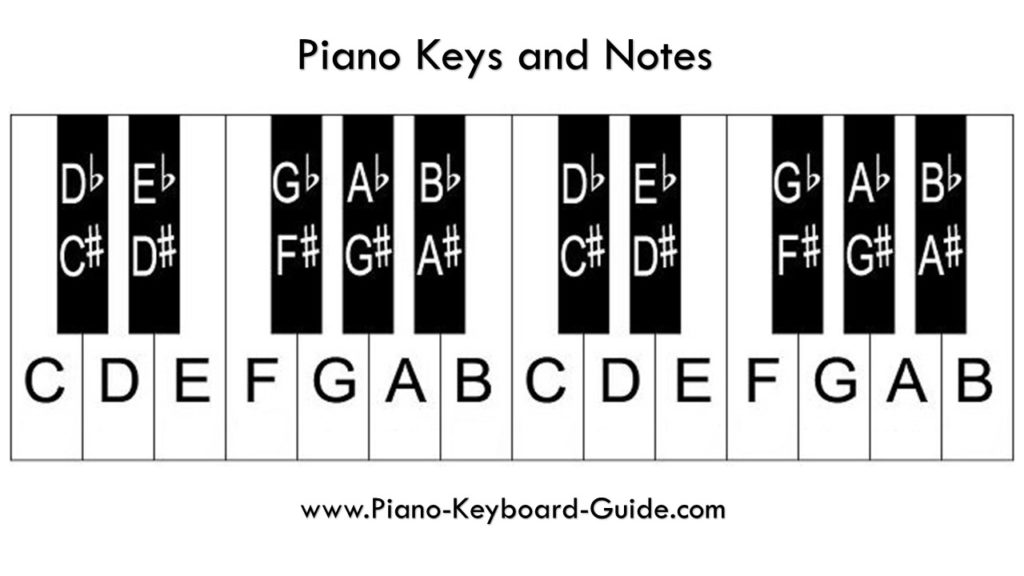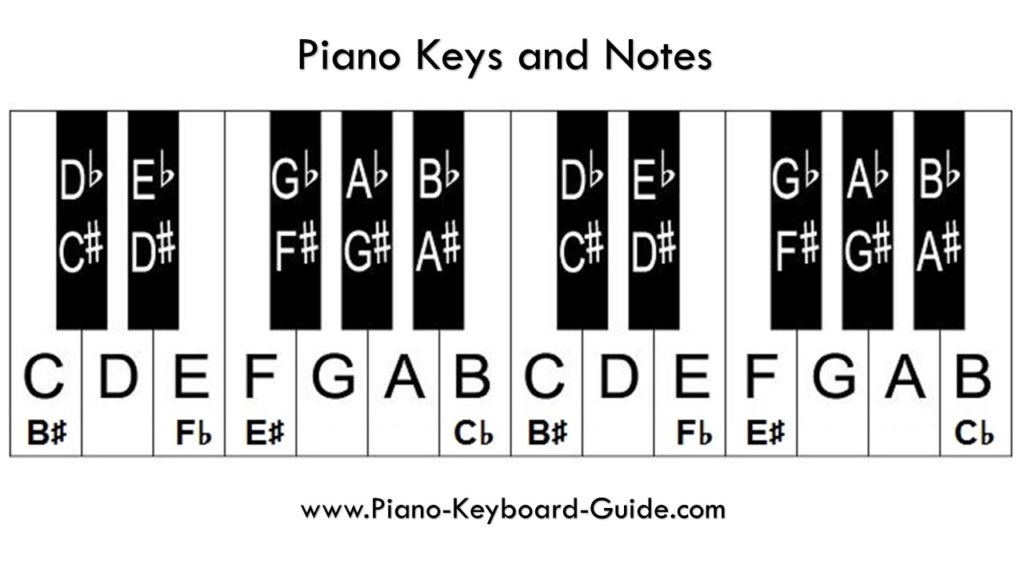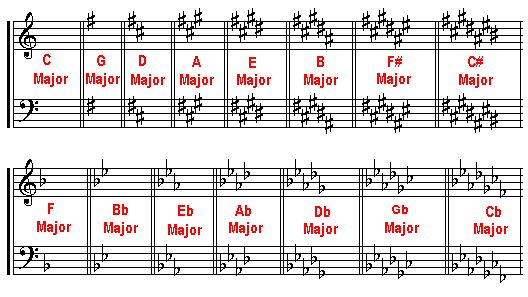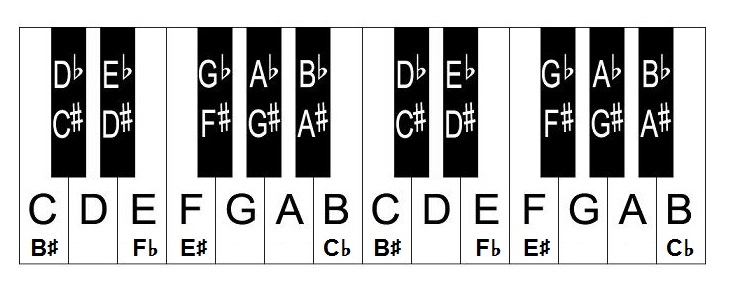
In this lesson, you will learn the notes that correspond to the keys of the piano keyboard. You will learn how to label the white and black keys. This is perfect for someone who’s just starting out on the piano. Maybe you just bought a new keyboard, you’re trying to figure out the notes, you want to learn some songs online or you’ve decided to begin learning to play the piano. This absolute beginner’s piano lesson is perfect for you. It’s based on a video (embedded below) that I posted on the Piano Keyboard Guide YouTube channel.
I will show you some basics right from the very start. So you’re looking at the piano keyboard and want to figure it out. What are the keys all about? You see black keys and white keys. When you play them you hear sounds. But what’s it all about? I will tell you what notes each key plays.
Piano Keys and Notes – PKG 001 (Watch this lesson.)
Piano Notes & Keys – The White Keys
First of all, I want you to take a look at the black keys. If you look closely at the piano keyboard you will see that you have a group of two black keys followed by a group of three black keys, then a group of two black keys followed by a group of three black keys, and this pattern of two – three – two – three – two – three continues. Do you notice this? We will use this pattern to identify and label the keys of the piano.
Before a set of two black keys, you will notice that there’s a white key. This white key plays the note, C. Try it out on your keyboard. Play C. There are many C notes on your keyboard. Play the one near the center of your keyboard. So if we know where the note, C is, we could name the other white keys. What letter comes after C? Clearly, it’s D. So the white key after C plays D. What letter comes after D? E comes after D. Therefore, the white key after D plays E. The note after E is F, followed by G, A, B and C. Play these notes and say their names out loud.
The musical alphabet consists of 7 notes, A B C D E F G. After G, you go back to A and repeat the notes. There is no H in music, just A B C D E F G.
Start on another C on your keyboard. Try one that’s lower on your keyboard. (Lower means that you’re playing a key that is to the left of what you played earlier.) Remember that C is the key before a set of two black keys. Play C D E F G A B C. After you play C D E F G A B, you arrive once again at another C note which is before a set of two black keys.
So by now, hopefully, you know how to label the white keys. I trust that you know where C, D, E, F, G, A and B are located. Play them and say their names out loud. Once again, anytime you have a set of two black keys, the white key immediately before it plays the note, C.
How about the set of three black keys we talked about earlier? The note before it, as you may have noticed earlier is F. F comes before a set of three black keys. So if you know where F is, you know where G is. G is immediately after F. After G, the notes are A, B, C, D, E, F, G and so on. Choose another set of three black keys and play the F key just before it. Say its name out loud, then play the other notes, G, A, B, C, D, and E and say their names. As long as you understand that C comes before a set of two black keys and F comes before a set of three black keys, you can label all the white keys of the piano keyboard. I created a few piano courses for you to help you improve. Learn all about them here.
Piano Notes and Keys – The Black Keys
Let’s now label the black keys. We will first of all take a look at sharps and flats. If you’re moving to the left of a key (playing a key that’s lower), the term “flat” is used. For instance, the key to the immediate left of D plays the note, D flat. D flat can be written like this: Db. A lower case “b” stands for flat. Play D on your keyboard, then play the black key just before D. You just played the note, Db. D flat is a semitone or a half step lower than D. If you move from D to C, you would be moving a whole step lower, but with a half step, no key is skipped. Play the note, E on your piano keyboard. Now play the key that is to the immediate left of it. What note does this key play? The answer is E flat (Eb). Eb flat is a half step lower than E. Play G, then go a half step (or semitone) lower to arrive at G flat (Gb). Play A, then go a half step lower to arrive at A flat (Ab). Ab is to the immediate left of (or a half step lower than) A. Play B, then go a half step lower to arrive at B flat (Bb). Bb is to the immediate left of (or a half step lower than) B.
So the black keys play the notes, Db Eb Gb Ab Bb. For the group of two black keys, it’s Db followed by Eb. For the group of three black keys, it’s Gb followed by Ab followed by Bb. Play the black keys and say the note names out loud. Play each white key then play the black key to the immediate left of it and say their names. Practice, practice, practice until you know it by heart.
Starting on C, and moving higher chromatically, the notes are C, Db, D, Eb, E, F, Gb, G, Ab, A, Bb, B, C. As can be seen, some of these notes are natural notes and some are flat notes.
The white keys play natural notes. C D E F G A B are natural notes. They have no sharps or flats. (We will take a look at sharps shortly.)
Starting on C, and moving higher chromatically, using natural notes and sharps, the notes are C, C#, D, D#, E, F, F#, G, G#, A, A#, B, C. The sharp notes are C# D# F# G# A#. For the set of two black keys, the notes are C# and D#. For the set of three black keys the notes are F#, G# and A#. Play each white key then play the black key to the immediate right of it and say their names. Practice, practice, practice until you master it.
In music, as we mentioned earlier, in addition to flats, we also have sharps. The sharp symbol looks almost like a hashtag. You can use this symbol when writing or typing: #. The sharp sign tells you to play a key that is a half step higher on your keyboard. Play the note, C then play the black key that is to the immediate right of it. That black key plays the note, C sharp (C#). Play the note, D then play the black key that is to the immediate right of it. That black key plays the note, D sharp (D#). Play the note, F then play the black key that is to the immediate right of it. That black key plays the note, F sharp (F#). Likewise, the black key immediately after G plays the note, G#. The black key immediately after A plays the note, A#.
So you can clearly see, that the black keys each have two note names. C is followed by C# and Db. The same black key plays C# and Db. D is followed by D# and Eb. The same black key plays D# and Eb. F is followed by F# and Gb. The same black key plays F# and Gb. G is followed by G# and Ab. The same black key plays G# and Ab. A is followed by A# and Bb. The same black key plays A# and Bb.
By now, you should know how to label all the keys of the piano. Watch the embedded youtube video to see me illustrate and please subscribe, share the video, like and comment.
Remember that moving from one key to the next (without skipping any keys) is called a half step or semitone. To take your playing to the next level, learn about the Piano For All course here.

If you were to stop reading right now and were new to labeling the keys of the piano, you’d probably think that the white keys have no sharps or flats while the black keys are either sharp or flat. However, this is not really the case. There is more to naming piano notes and keys. As you progress as a piano student, you will understand more clearly that white keys can play sharps or flats as well. This often confuses beginners and those who are new to music theory. They wrongly think or assume that there is no E#, Fb, Cb and B#, for instance.
This often comes up on my Piano Keyboard Guide youtube channel in comments, particularly for a video I created on how to play the song, Faded by Alan Walker, where I labeled a note, E# in the melody. This really confused some beginners, because I played the same key that plays F and called it E#. To cut a long story short, in music, E# exists and so does, B#, Cb, Fb and so on.
Any note can be sharp or flat. Think of sharp as telling you to play a note that is a half step higher than a note. So if you’re on E and I ask you to play E#, you simply have to play the key that is a half step higher. You’d be using the same key that is used to play F and that’s okay. The note that plays E, can play Fb in some cases because it is a half step lower than F. The note that plays B, can play Cb in some cases because it is a half step lower than C. It all depends on what key you’re playing in and you will learn more about this later as you progress as a piano student.
On a music sheet, a flat may be placed before a note, indicating that you should play it a half step lower. So let’s say the flat symbol is placed before the note C on the staff. It means that instead of C, you should play Cb which is a half step lower than C.
A sharp symbol may be placed before a note. Let’s say the sharp symbol is placed before the note B on the staff. It means that instead of B, you should play B# which is a half step higher than B. The piano keyboard diagram on this page should make all of this clearer. You will realize that keys, whether white or black, can play more than one note. If you have any question about this, you can ask it below.
One more thing I want you to understand is that there is a difference between piano keys and notes. Piano keys are not notes. Piano keys are used to play notes. So there is really no key called C, D, E, F, G, A, B and so on. The keys are used to play these notes.
I hope you understand how to label the keys of the piano keyboard or what notes each key plays. Keep practicing by playing a note and saying its name out loud. Thank you very much and all the best. Learn more about piano keys and notes.

